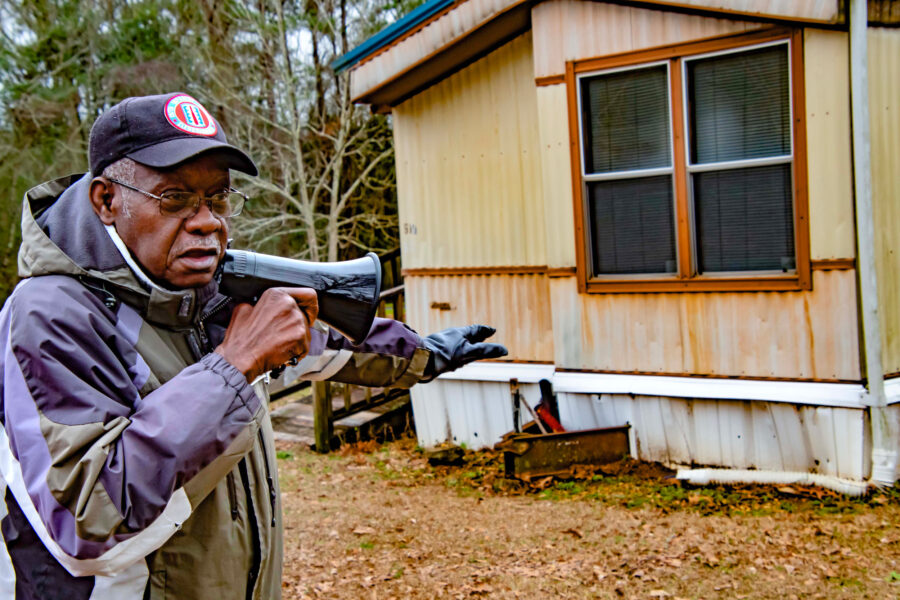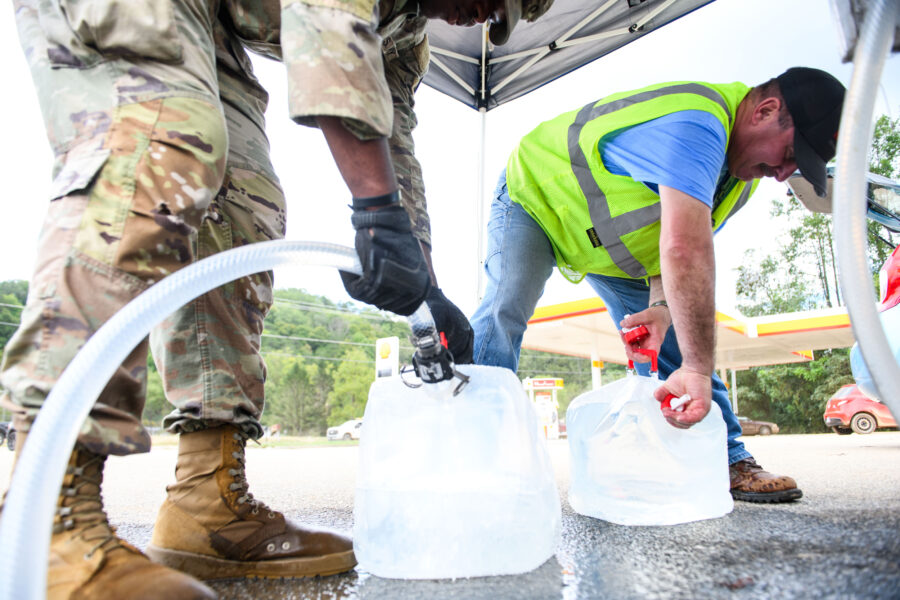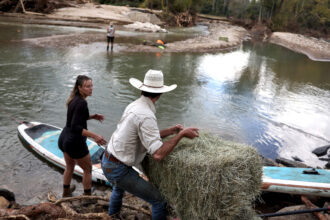Hurricane Helene Lays Bare the Growing Threat of Inland Flooding
Six months ago, Craig Colten moved from Baton Rouge, Louisiana, to Asheville, North Carolina—a historic city tucked in the Blue Ridge Mountains. He’d fallen in love with the region over the summers while in college and was eager to evade the near-constant threat of hurricanes that loomed over his life in Louisiana.
“I moved up here as a climate migrant,” he told me, echoing the sentiment of many other recent Asheville transplants.
However, Colten has been studying hurricanes as a historical geographer for decades, and he knew there was no true escape from climate change when Hurricane Helene ripped through the Southeast last week.
The storm and ensuing floods killed at least 130 people and have left millions without power. Helene was particularly devastating for towns in western North Carolina, including Asheville—which is located more than 500 miles inland from where the hurricane first made landfall in Florida. This destruction lays bare the growing threat that inland communities face as climate change makes storms more severe.
Storms Beyond the Coast: On Sept. 25, the National Oceanic and Atmospheric Administration (NOAA) pushed out an urgently worded news release warning communities to prepare for “catastrophic, life-threatening inland flooding” from Hurricane Helene, which was expected to bring severe winds and up to 18 inches in the southern Appalachians region.
The forecasts were chillingly accurate. After tearing through Florida’s Big Bend region last Thursday—which my colleague Amy Green wrote about—the hurricane rapidly weakened overnight as it spread further inland, but still inundated counties across Georgia, Tennessee and North Carolina. In the mountains of western North Carolina, intense rainfall triggered landslides that destroyed houses and caused parts of the French Broad River to flood onto the streets in several spots, including Asheville. The Swannanoa River—a major tributary of the French Broad—crested at just over 26 feet, the highest level it has been since 1791. At least 49 people in the region are dead.
Though the storm has stopped, different disasters are unfolding as the water recedes. On Sunday, city officials announced that nearly 100,000 Asheville residents may not have access to water for weeks due to extensive storm damage to water pipes and treatment facilities.
“People are really living in a state of anxiety and shortage of basics, power and water,” said Colten, a professor emeritus at Louisiana State University. He lives higher up in the mountain than many parts of the city and was able to avoid major flood damage, but does not have power and is running out of supplies like water and canned goods. “I think the city … didn’t have a full plan in place.”
Emergency responders are struggling to get supplies to Asheville residents because fallen trees and flooding are blocking major roads. Another factor inhibiting rescue and recovery efforts is the lack of communication options, a common problem during weather-related disasters, Colten said.
Cell service is out in many parts of Asheville; in fact, Colten had to drive further up the mountain to find a signal to call me. Families across the Southeast are still struggling to get a hold of loved ones to determine if they are alive and well. Despite alerts from NOAA’s National Weather Service before, during and after the storm, many were caught off-guard by the sheer force of the rain and winds and failed to adequately prepare or evacuate, according to Blue Ridge Public Radio’s Lilly Knoepp.
Part of this could be due to differences in how people living inland perceive hurricane risks compared to those along the coast, according to a 2020 study. Using survey data collected in the U.S. after Hurricanes Florence, Michael, Barry and Dorian, researchers found that coastal populations evacuated at a higher rate than their inland counterparts in every storm they studied.
When it comes to Helene’s impact on North Carolina, “a lot of people here felt like they were safe from this,” said Colten, who was not involved in the study.
More Floods to Come: Although Asheville has been called a “climate haven” by some in the past, it’s not the first time major floods have hit the region. In 1916, tropical storms that originated in Mississippi and South Carolina caused unprecedented flooding in the Asheville area. The floods killed around 80 people and caused millions of dollars worth of damage. Back-to-back tropical storms hit the region again in 2004.
Other inland areas are facing similar issues from storms, including Vermont, upstate New York and parts of Texas. Allegheny County in Pittsburgh, Pennsylvania, faces an estimated $1.1 billion in flood damages every year. Though the area is a couple hundred miles from the nearest ocean, it is located at the intersection of three rivers, which frequently overflow during severe storms.
Inland flooding is projected to get worse as climate change continues, according to the Fifth National Climate Assessment, released in 2020. When the atmosphere heats up, the air traps more water vapor, which can be quickly unleashed during a severe storm like Helene. However, not every area is factoring this climate problem into their emergency management plans.
Most flood risk maps created by the Federal Emergency Management Agency are based on past rainfall patterns, failing to incorporate the potential uptick in rain forecasted by leading climate models. A 2020 report by the climate risk modeling firm First Street found that 5.9 million property owners are currently unaware of or are underestimating the risk they face from flooding because FEMA had not yet identified the areas as special flood zones. Research shows that inland residents are also less likely to have flood insurance than populations along the coast.
Nonprofits and concerned residents are pushing FEMA to better incorporate climate risks into its maps. In the meantime, First Street and other groups like the Environmental Defense Fund and Texas A&M University have created their own tools to help homeowners track flood risk.
Adaptation measures can help inland towns increase their resilience to extreme flood events like those caused by Helene, experts say. They include increasing disaster awareness and preparedness among residents, expanding stormwater drainage systems and reinforcing water mains to ensure that they do not break during severe weather events.
More Top Climate News
With many roads destroyed or flooded, emergency responders are bringing supplies to Helene-impacted communities in North Carolina using planes—and mules, Jeffrey Collins reports for The Associated Press. Mules are able to climb through rugged terrain carrying heavy packs of food and water, otherwise difficult to get to isolated areas across the state.
“We’ll take our chainsaws, and we’ll push those mules through,” Mike Toberer, a trainer at Mountain Mule Packer Ranch, told the AP.
In a rare bit of good news, the Coast Guard rescued a man and his dog off the Florida coast after their boat capsized while he was attempting to relocate ahead of the storm, Sydney Page reports for The Washington Post. In Tennessee, emergency workers were also able to rescue dozens of people stranded on top of a hospital roof. Search and rescue operations are underway as many counties across the Southeast remain submerged, with around 600 people still missing, White House Homeland Security Adviser Elizabeth Sherwood-Randall said Monday during a press briefing.
Meanwhile, in Nepal, torrential downpours triggered flooding and landslides that have killed at least 193 people over the past week, officials say. The damage has been catastrophic; hundreds of homes are destroyed and power lines are down across the country, Bhadra Sharma and Anupreeta Das report for The New York Times. More than 3,600 people have been rescued so far, but rescue operations continue.
A small fire at BioLab, a Georgia-based manufacturer of pool and spa treatment products, released a plume of smoke and chemicals across Rockdale County on Sunday, forcing 90,000 people across the region to shelter-in-place. On Monday evening, the U.S. Environmental Protection Agency announced that it is now safe for residents to go outside, The New York Times reports. However, residents east of Atlanta were warned today to shelter-in-place again due to changing weather. Some locals are calling for the company to be shut down entirely, fearing future chemical risks.
Climate activists from the youth-led Sunrise Movement protested outside of CBS News headquarters ahead of the upcoming vice presidential debate, urging moderator Norah O’Donnell to ask questions about climate change. The group wants O’Donnell to press JD Vance, former President Donald Trump’s running mate, to actually answer such questions. Trump largely sidestepped climate questions at the two presidential debates.
About This Story
Perhaps you noticed: This story, like all the news we publish, is free to read. That’s because Inside Climate News is a 501c3 nonprofit organization. We do not charge a subscription fee, lock our news behind a paywall, or clutter our website with ads. We make our news on climate and the environment freely available to you and anyone who wants it.
That’s not all. We also share our news for free with scores of other media organizations around the country. Many of them can’t afford to do environmental journalism of their own. We’ve built bureaus from coast to coast to report local stories, collaborate with local newsrooms and co-publish articles so that this vital work is shared as widely as possible.
Two of us launched ICN in 2007. Six years later we earned a Pulitzer Prize for National Reporting, and now we run the oldest and largest dedicated climate newsroom in the nation. We tell the story in all its complexity. We hold polluters accountable. We expose environmental injustice. We debunk misinformation. We scrutinize solutions and inspire action.
Donations from readers like you fund every aspect of what we do. If you don’t already, will you support our ongoing work, our reporting on the biggest crisis facing our planet, and help us reach even more readers in more places?
Please take a moment to make a tax-deductible donation. Every one of them makes a difference.
Thank you,
David Sassoon
Founder and Publisher
Vernon Loeb
Executive Editor
Share this article
- Republish
Disclaimer: The copyright of this article belongs to the original author. Reposting this article is solely for the purpose of information dissemination and does not constitute any investment advice. If there is any infringement, please contact us immediately. We will make corrections or deletions as necessary. Thank you.







